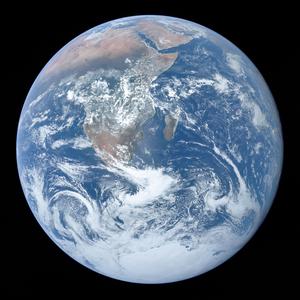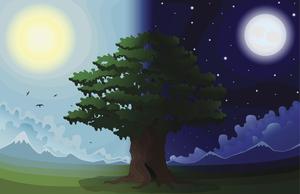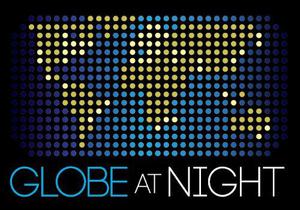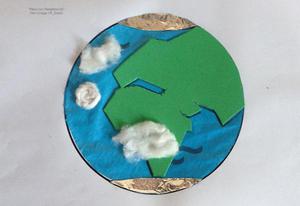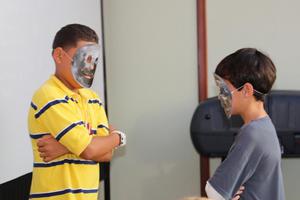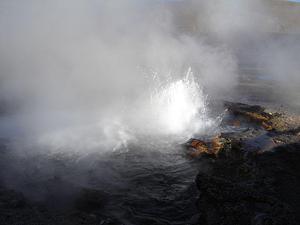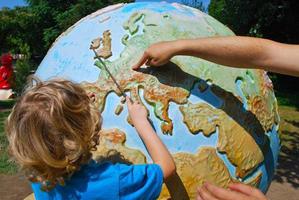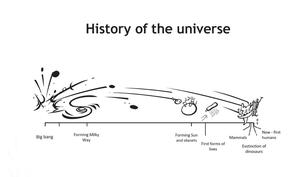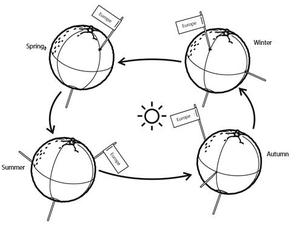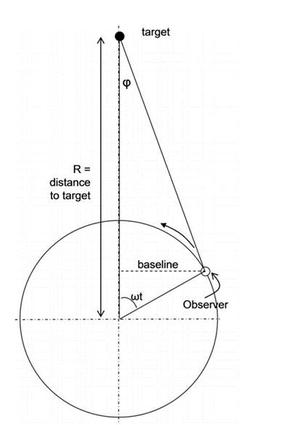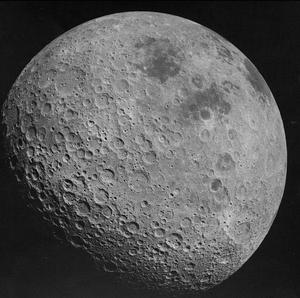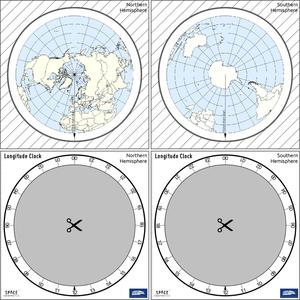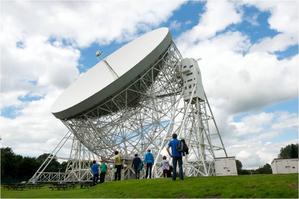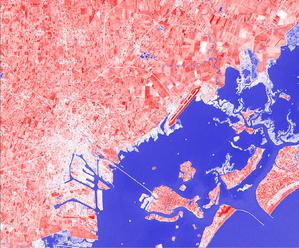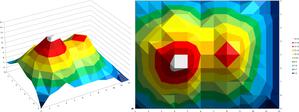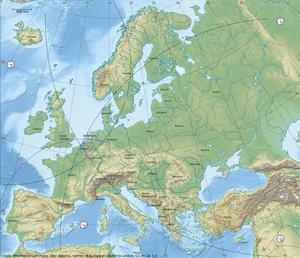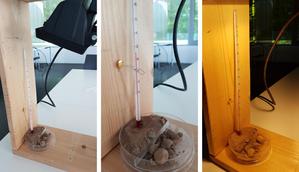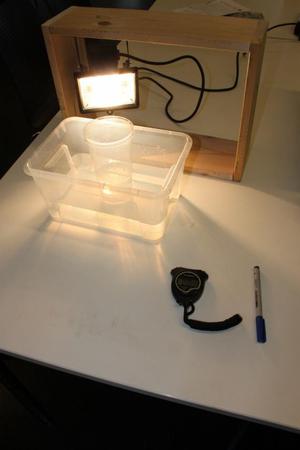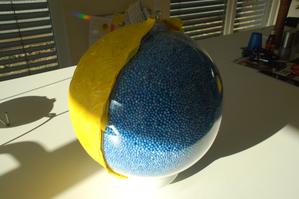Termine del Glossario Terra
Descrizione La Terra è il terzo pianeta a partire dal Sole, ed è il quinto pianeta più grande del Sistema Solare. È un pianeta roccioso e terrestre con un raggio di circa 6.400 chilometri (km). Ha una massa di circa 6.000 miliardi di chilogrammi.
La distanza tipica della Terra dal Sole è approssimativamente di 150 milioni di chilometri. Questa distanza è definita come una Unità Astronomica. La Terra ne impiega 365,26 per completare l'orbita del Sole. La Terra ha un satellite naturale, la Luna.
La Terra ospita milioni di specie di esseri viventi, tra cui gli esseri umani; è l'unico luogo dell'Universo ad oggi conosciuto che ospita la vita. Si ritiene che si sia formata all'incirca 4,54 miliardi di anni fa. La Terra è dotata di un'atmosfera e di una magnetosfera che bloccano le radiazioni nocive, permettendo così la moltiplicazione degli organismi viventi. La Terra ha anche un'ampia superficie d'acqua (l'unico pianeta conosciuto del sistema solare che possieda questa caratteristica ), che le conferisce un colore blu.
Termini correlati
Vedi questo termine in altre lingue
status del termine e della definizione La definizione originale di questo termine in inglese é stata approvata da un ricercatore astronomo e da un docente La traduzione di questo termine e della sua definizione sono ancora in attesa di approvazione
Il Glossario Multilingue OAE é un progetto dell'Ufficio IAU per la didatticadell'astronomia (OAE) in collaborazione con l'ufficio IAU OAO per la DivulgazioneAstronomica (OAO). I termini e le definizioni sono stater scelte, scritte eriviste da un impegno collettivo da parte di OAE, i Centri e i Nodi OAE e iCoordinatori Nazionali per la Didattica dell'Astronomia e da altri volontari.Potete trovare una lista completa dei crediti, Tutti i termini del glossarioE le definizioni sono pubblicate su Creative Commons CC BY-4.0 licenza e dovrebbero essere accreditate ad IAU OAE.
Mass Media correlati
La Terra vista dall'Apollo 17
Crediti: NASA/Equipaggio dell'Apollo 17/Archivio del Progetto Apollo
License: PD Dominio Pubblico icone
Attività correlate
Design Your Alien
astroEDU educational activity (links to astroEDU website) Description: Design an alien life form suited for an extra-terrestrial world.License: CC-BY-4.0 Creative Commons Attribuzione 4.0 Internazionale (CC BY 4.0) icone
Etichette: Life , Environment , Extra-terrestrial , Art , Creativity , Hands-on , Alien Fasce d'età 8-10 , 10-12 Livello di istruzione Primary , SecondaryWhy Do We Have Day and Night?
astroEDU educational activity (links to astroEDU website) Description: Explore day and night of Earth.License: CC-BY-4.0 Creative Commons Attribuzione 4.0 Internazionale (CC BY 4.0) icone
Etichette: Tilt Fasce d'età 6-8 , 8-10 , 10-12 Livello di istruzione Primary , Secondary Aree di apprendimento Modelling , Structured-inquiry learning , Social Research Costi: Low Cost Durata: 1 hour 30 mins Dimensione del Gruppo: Group Abilità: Asking questions , Communicating informationGlobe at Night Activity Guide
astroEDU educational activity (links to astroEDU website) Description: Learn to observe and record the faintest visible stars to measure the light pollution.License: CC-BY-4.0 Creative Commons Attribuzione 4.0 Internazionale (CC BY 4.0) icone
Etichette: Hands-on , Dark skies , ecology , Citizen science Fasce d'età 4-6 , 6-8 , 8-10 , 10-12 , 12-14 , 14-16 , 16-19 , 19+ Livello di istruzione Informal , Middle School , Other , Primary , Secondary , University Aree di apprendimento Observation based , Project-based learning Costi: Low Cost Dimensione del Gruppo: Group Abilità: Communicating information , Planning and carrying out investigationsMeet Our Home: Planet Earth
astroEDU educational activity (links to astroEDU website) Description: Explore a tactile version of our home, the Earth, with household materials.License: CC-BY-4.0 Creative Commons Attribuzione 4.0 Internazionale (CC BY 4.0) icone
Etichette: Hands-on , Model , Visually Impaired , Tactile Fasce d'età 6-8 , 8-10 , 10-12 Livello di istruzione Middle School , Primary , Secondary Aree di apprendimento Interactive Lecture , Modelling Costi: Low Cost Durata: 1 hour 30 mins Dimensione del Gruppo: Group Abilità: Analysing and interpreting data , Asking questions , Communicating information , Developing and using modelsBlue Marble in Empty Space
astroEDU educational activity (links to astroEDU website) Description: Students are taken on a virtual journey to outer space to experience that we live on a tiny planet that floats in a vast and empty space.License: CC-BY-4.0 Creative Commons Attribuzione 4.0 Internazionale (CC BY 4.0) icone
Etichette: Life , Hands-on , Model , Scales , Distances , ISS Fasce d'età 6-8 , 8-10 Livello di istruzione Primary , Secondary Aree di apprendimento Interactive Lecture , Modelling Costi: Low Cost Durata: 30 mins Dimensione del Gruppo: Group Abilità: Asking questions , Communicating information , Developing and using modelsLunar Day
astroEDU educational activity (links to astroEDU website) Description: Through a fun-learning activity, understand why moon always keeps the same face towards Earth.License: CC-BY-4.0 Creative Commons Attribuzione 4.0 Internazionale (CC BY 4.0) icone
Etichette: Lunar day Fasce d'età 4-6 , 6-8 Livello di istruzione Primary , Secondary Aree di apprendimento Modelling , Structured-inquiry learning Costi: Free Durata: 30 mins Dimensione del Gruppo: Group Abilità: Analysing and interpreting data , Asking questions , Communicating information , Constructing explanations , Developing and using modelsFizzy Balloons – CO2 in School
astroEDU educational activity (links to astroEDU website) Description: Investigate the properties of carbon dioxide with this fun demonstration.License: CC-BY-4.0 Creative Commons Attribuzione 4.0 Internazionale (CC BY 4.0) icone
Etichette: Life , Hands-on , Chemistry , Earth Science , Carbon Dioxide Fasce d'età 8-10 , 10-12 Livello di istruzione Primary , Secondary Aree di apprendimento Interactive Lecture , Traditional Science Experiment Costi: Medium Cost Durata: 2 hours Dimensione del Gruppo: Group Abilità: Analysing and interpreting data , Asking questions , Constructing explanations , Engaging in argument from evidence , Planning and carrying out investigationsDay and Night in the World
astroEDU educational activity (links to astroEDU website) Description: Compare diurnal and nocturnal animals and experiment with day and night.License: CC-BY-4.0 Creative Commons Attribuzione 4.0 Internazionale (CC BY 4.0) icone
Etichette: Life , Model , Animals , Day and night Fasce d'età 6-8 , 8-10 Livello di istruzione Primary Aree di apprendimento Interactive Lecture , Modelling , Social Research Costi: Low Cost Durata: 1 hour Dimensione del Gruppo: Group Abilità: Asking questions , Constructing explanations , Developing and using models , Planning and carrying out investigationsLet's Map the Earth
astroEDU educational activity (links to astroEDU website) Description: Discover how to read and draw maps by observing.License: CC-BY-4.0 Creative Commons Attribuzione 4.0 Internazionale (CC BY 4.0) icone
Etichette: Hands-on , Scales , Geography , Maps , GPS , Coordinates Fasce d'età 8-10 , 10-12 Livello di istruzione Primary Aree di apprendimento Modelling , Social Research Costi: Low Cost Durata: 1 hour Dimensione del Gruppo: Group Abilità: Analysing and interpreting dataHistory of the Universe
astroEDU educational activity (links to astroEDU website) Description: Build a timeline of the all Universe!License: CC-BY-4.0 Creative Commons Attribuzione 4.0 Internazionale (CC BY 4.0) icone
Etichette: History , Timeline , Mathematics , Humans Fasce d'età 8-10 , 10-12 , 12-14 Livello di istruzione Middle School , Primary Aree di apprendimento Problem-solving , Social Research Costi: Low Cost Durata: 1 hour 30 mins Dimensione del Gruppo: Group Abilità: Asking questions , Communicating information , Developing and using models , Using mathematics and computational thinkingSun, Earth and Moon Model
astroEDU educational activity (links to astroEDU website) Description: Build an Earth-Moon-Sun mobile to learn about how they orbit.License: CC-BY-4.0 Creative Commons Attribuzione 4.0 Internazionale (CC BY 4.0) icone
Etichette: Hands-on , Model Fasce d'età 8-10 Livello di istruzione Primary Aree di apprendimento Game-mediated learning , Modelling , Social Research Costi: Medium Cost Durata: 1 hour 30 mins Dimensione del Gruppo: Group Abilità: Asking questions , Communicating information , Developing and using modelsContinental Climate and Oceanic Climate
astroEDU educational activity (links to astroEDU website) Description: Find out why, in the summer it is cooler by the sea than on the land!License: CC-BY-4.0 Creative Commons Attribuzione 4.0 Internazionale (CC BY 4.0) icone
Etichette: Climate change , Climate , Ocean Fasce d'età 6-8 , 8-10 Livello di istruzione Primary Aree di apprendimento Modelling , Social Research , Traditional Science Experiment Costi: Medium Cost Durata: 45 mins Dimensione del Gruppo: Group Abilità: Analysing and interpreting data , Asking questions , Constructing explanations , Engaging in argument from evidence , Planning and carrying out investigationsInvestigating the Atmosphere – Air Takes Up Space
astroEDU educational activity (links to astroEDU website) Description: Air takes up space even though you cannot see it.License: CC-BY-4.0 Creative Commons Attribuzione 4.0 Internazionale (CC BY 4.0) icone
Etichette: Geography , Mathematics , Air Fasce d'età 6-8 , 8-10 Livello di istruzione Primary Aree di apprendimento Modelling , Social Research Costi: Low Cost Durata: 1 hour Dimensione del Gruppo: Group Abilità: Analysing and interpreting data , Asking questions , Communicating information , Constructing explanations , Planning and carrying out investigationsSeasons Around the World
astroEDU educational activity (links to astroEDU website) Description: Demonstrate the seasons on Earth using a model.License: CC-BY-4.0 Creative Commons Attribuzione 4.0 Internazionale (CC BY 4.0) icone
Etichette: Hands-on , Model Fasce d'età 6-8 , 8-10 , 10-12 Livello di istruzione Middle School , Primary Aree di apprendimento Modelling , Social Research Costi: Medium Cost Durata: 45 mins Dimensione del Gruppo: Group Abilità: Analysing and interpreting data , Asking questions , Constructing explanations , Developing and using models , Planning and carrying out investigationsHow To Travel on Earth Without Getting Lost
astroEDU educational activity (links to astroEDU website) Description: Use a globe to describe your position on Earth.License: CC-BY-4.0 Creative Commons Attribuzione 4.0 Internazionale (CC BY 4.0) icone
Etichette: Geography , Maps , GPS , Celestial navigation Fasce d'età 8-10 , 10-12 , 12-14 Livello di istruzione Middle School , Primary Aree di apprendimento Social Research Costi: Low Cost Durata: 1 hour Dimensione del Gruppo: Group Abilità: Analysing and interpreting data , Developing and using models , Using mathematics and computational thinkingThe 4-Point Backyard Diurnal Parallax Method
astroEDU educational activity (links to astroEDU website) Description: Measure the distance to an asteroid with a novel techniqueLicense: CC-BY-4.0 Creative Commons Attribuzione 4.0 Internazionale (CC BY 4.0) icone
Etichette: Hands-on , Measurement , Distances , CCD imaging , astrometry Fasce d'età 16-19 , 19+ Livello di istruzione Informal , Secondary , University Aree di apprendimento Guided-discovery learning , Project-based learning Costi: High Cost Durata: several days Dimensione del Gruppo: Group Abilità: Analysing and interpreting data , Asking questions , Communicating information , Constructing explanations , Planning and carrying out investigations , Using mathematics and computational thinkingImpact Craters
astroEDU educational activity (links to astroEDU website) Description: A literal Earth-Shattering experimentLicense: CC-BY-4.0 Creative Commons Attribuzione 4.0 Internazionale (CC BY 4.0) icone
Etichette: History , Impact , Experiment Fasce d'età 10-12 , 12-14 , 14-16 Livello di istruzione Middle School , Primary , Secondary Aree di apprendimento Guided-discovery learning , Modelling , Traditional Science Experiment Costi: Low Cost Durata: 1 hour Dimensione del Gruppo: Group Abilità: Analysing and interpreting data , Asking questions , Constructing explanations , Engaging in argument from evidence , Using mathematics and computational thinkingMeteoroids, Meteors and Meteorites
astroEDU educational activity (links to astroEDU website) Description: Unveiling the mystery of "shooting stars": meteors, meteorites and meteroidsLicense: CC-BY-4.0 Creative Commons Attribuzione 4.0 Internazionale (CC BY 4.0) icone
Etichette: Geology Fasce d'età 6-8 , 8-10 , 10-12 , 12-14 Livello di istruzione Middle School , Primary Aree di apprendimento Interactive Lecture Costi: Low Cost Durata: 1 hour 30 mins Dimensione del Gruppo: Group Abilità: Analysing and interpreting data , Asking questions , Communicating information , Engaging in argument from evidenceThe Intertropical Convergence Zone
astroEDU educational activity (links to astroEDU website) Description: The air circulation system: how are winds created?License: CC-BY-4.0 Creative Commons Attribuzione 4.0 Internazionale (CC BY 4.0) icone
Etichette: Climate , Updraft , Convection , Winds Fasce d'età 12-14 , 14-16 Livello di istruzione Middle School Aree di apprendimento Discussion Groups , Modelling , Social Research Costi: Medium Cost Durata: 1 hour Dimensione del Gruppo: Group Abilità: Communicating information , Constructing explanations , Developing and using models , Engaging in argument from evidence , Planning and carrying out investigationsThe Quest for Longitude
astroEDU educational activity (links to astroEDU website) Description: How to navigate at sea like an explorer?License: CC-BY-4.0 Creative Commons Attribuzione 4.0 Internazionale (CC BY 4.0) icone
Etichette: Clocks , Geography , Coordinates , Celestial navigation , James Cook , Exploration Fasce d'età 14-16 , 16-19 Livello di istruzione Middle School , Secondary Aree di apprendimento Discussion Groups , Modelling , Social Research Costi: Low Cost Durata: 2 hours Dimensione del Gruppo: Group Abilità: Analysing and interpreting data , Asking questions , Communicating information , Developing and using models , Planning and carrying out investigations , Using mathematics and computational thinkingBig Telescopes: Gravity
astroEDU educational activity (links to astroEDU website) Description: Observing what gravity is doing to the UniverseLicense: CC-BY-4.0 Creative Commons Attribuzione 4.0 Internazionale (CC BY 4.0) icone
Etichette: Experiment Fasce d'età 12-14 , 14-16 Livello di istruzione Middle School , Secondary Aree di apprendimento Guided-discovery learning , Interactive Lecture , Modelling Costi: High Cost Durata: 1 hour 30 mins Dimensione del Gruppo: Group Abilità: Analysing and interpreting data , Asking questions , Developing and using models , Planning and carrying out investigationsThe Climate in Numbers and Graphs
astroEDU educational activity (links to astroEDU website) Description: Learn about climate from data and graphsLicense: CC-BY-4.0 Creative Commons Attribuzione 4.0 Internazionale (CC BY 4.0) icone
Etichette: Climate , Average , Climate zone , Weather Fasce d'età 14-16 , 16-19 Livello di istruzione Secondary Aree di apprendimento Social Research Costi: Low Cost Durata: 2 hours Dimensione del Gruppo: Group Abilità: Analysing and interpreting data , Asking questions , Communicating information , Constructing explanations , Developing and using models , Engaging in argument from evidence , Using mathematics and computational thinkingA View from Above
astroEDU educational activity (links to astroEDU website) Description: How do satellites take images of the Earth surface and how do we analyse and use them?License: CC-BY-4.0 Creative Commons Attribuzione 4.0 Internazionale (CC BY 4.0) icone
Etichette: Maps , Climate , Landsat , Earth observation , Sentinel , Copernicus , Remote sensing , Vegetation Fasce d'età 14-16 , 16-19 Livello di istruzione Middle School , Secondary Aree di apprendimento Social Research Costi: Low Cost Durata: 1 hour 30 mins Dimensione del Gruppo: Group Abilità: Analysing and interpreting data , Asking questions , Communicating information , Constructing explanations , Developing and using models , Engaging in argument from evidence , Using mathematics and computational thinkingValleys Deep and Mountains High
astroEDU educational activity (links to astroEDU website) Description: Learn how radar altimetry from satellites works and how to put landscapes on paper.License: CC-BY-4.0 Creative Commons Attribuzione 4.0 Internazionale (CC BY 4.0) icone
Etichette: Maps , Earth observation , Sentinel , Copernicus , Remote sensing , Altimetry , Radar Fasce d'età 14-16 , 16-19 Livello di istruzione Middle School , Secondary Aree di apprendimento Discussion Groups , Modelling , Social Research Costi: Medium Cost Durata: 2 hours Dimensione del Gruppo: Group Abilità: Analysing and interpreting data , Asking questions , Communicating information , Developing and using models , Using mathematics and computational thinkingWhere on Earth am I?
astroEDU educational activity (links to astroEDU website) Description: How do satellite-based positioning and GPS navigation work?License: CC-BY-4.0 Creative Commons Attribuzione 4.0 Internazionale (CC BY 4.0) icone
Etichette: Clocks , Geography , Maps , GPS , Countries , Speed of light , Galileo Fasce d'età 14-16 Livello di istruzione Middle School Aree di apprendimento Guided-discovery learning , Problem-solving Costi: Low Cost Durata: 1 hour 30 mins Dimensione del Gruppo: Group Abilità: Analysing and interpreting data , Asking questions , Communicating information , Constructing explanations , Developing and using models , Using mathematics and computational thinkingOceans As A Heat Reservoir
astroEDU educational activity (links to astroEDU website) Description: Why do oceans play an important role in mitigating global warming?License: CC-BY-4.0 Creative Commons Attribuzione 4.0 Internazionale (CC BY 4.0) icone
Etichette: Life , Climate change , Oceans , heat Fasce d'età 12-14 , 14-16 , 16-19 Livello di istruzione Middle School Aree di apprendimento Modelling , Social Research , Traditional Science Experiment Costi: Medium Cost Durata: 1 hour 30 mins Dimensione del Gruppo: Group Abilità: Analysing and interpreting data , Constructing explanations , Developing and using models , Engaging in argument from evidence , Planning and carrying out investigationsTransforming water into acid… and back
astroEDU educational activity (links to astroEDU website) Description: Are our oceans turning to acid? Lets' learn how water turns in acid and back.License: CC-BY-4.0 Creative Commons Attribuzione 4.0 Internazionale (CC BY 4.0) icone
Etichette: Life , Chemistry , Carbon Dioxide , Climate change , Oceans , Acidification , pH value , Carbon cycle Fasce d'età 10-12 , 12-14 , 14-16 Livello di istruzione Middle School Aree di apprendimento Social Research , Traditional Science Experiment Costi: Medium Cost Durata: 45 mins Dimensione del Gruppo: Group Abilità: Analysing and interpreting data , Asking questions , Communicating information , Constructing explanations , Developing and using models , Engaging in argument from evidence , Planning and carrying out investigationsThe Big Meltdown
astroEDU educational activity (links to astroEDU website) Description: Learn what would happen on Earth if all the ice melted!License: CC-BY-4.0 Creative Commons Attribuzione 4.0 Internazionale (CC BY 4.0) icone
Etichette: Life , Climate change , Remote sensing , Oceans , Water , Antarctic , Arctic , Ice , Archimedes Fasce d'età 8-10 , 10-12 , 12-14 Livello di istruzione Middle School , Primary , Secondary Aree di apprendimento Discussion Groups , Modelling , Social Research , Traditional Science Experiment Costi: Medium Cost Durata: 45 mins Dimensione del Gruppo: Group Abilità: Analysing and interpreting data , Asking questions , Communicating information , Constructing explanations , Developing and using models , Engaging in argument from evidence , Planning and carrying out investigationsNavigate like a Viking – Use the Sun, not your phone!
astroEDU educational activity (links to astroEDU website) Description: Learn how the Vikings used the sky to navigate at sea with a hands-on activity!License: CC-BY-4.0 Creative Commons Attribuzione 4.0 Internazionale (CC BY 4.0) icone
Etichette: History , Geography , Maps , Coordinates , Celestial navigation Fasce d'età 12-14 , 14-16 Livello di istruzione Middle School Aree di apprendimento Discussion Groups , Modelling , Social Research Costi: Medium Cost Durata: 1 hour 30 mins Dimensione del Gruppo: Group Abilità: Analysing and interpreting data , Asking questions , Communicating information , Developing and using models , Planning and carrying out investigations , Using mathematics and computational thinkingOne Million Earths inside our Sun
astroEDU educational activity (links to astroEDU website) Description: Learn how to build a model of the Sun...which can fit nearly 1 million little Earth balls!License: CC-BY-4.0 Creative Commons Attribuzione 4.0 Internazionale (CC BY 4.0) icone
Etichette: Hands-on , Model , Scales , Distances , Dimension , Relative sizes Fasce d'età 4-6 , 6-8 , 8-10 , 10-12 , 12-14 , 14-16 , 16-19 , 19+ Livello di istruzione Informal , Middle School , Other , Pre-school , Primary , Secondary , University Aree di apprendimento Guided-discovery learning , Modelling , Problem-solving Costi: Medium Cost Durata: 30 mins Dimensione del Gruppo: Group Abilità: Analysing and interpreting data , Asking questions , Communicating information , Developing and using models , Using mathematics and computational thinking